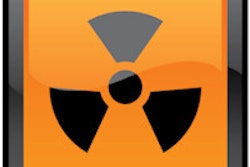CT wins the cost-benefit analysis in most cancer screening tests involving the modality, but the risks of ionizing radiation aren't negligible and should continue to be scrutinized as a factor in screening decisions, according to an article in the July edition of the American Journal of Roentgenology.
In a review of the literature on radiation carcinogenesis that evaluates the risk of malignancy from screening CT exams, Dr. Jeffrey Alpert from MD Anderson Cancer Center concluded that the data show a small but genuine risk of radiation-induced malignancy from CT scans. The analysis found that lung and colorectal cancer screening are good bets, but whole-body CT almost never is.
"CT is being actively explored for cancer screening, including lung cancer, colorectal cancer, and whole-body screening," Alpert wrote. "Given the radiation risk from CT, it is important to balance the benefit of early cancer detection with the potential risk of screening-induced malignancy" (AJR, July 2013, Vol. 201:1, pp. W81-W87).
The risks
Ionizing radiation can damage DNA, either directly due to an ejected electron or indirectly through the production of free radicals, such as hydroxyl radicals formed from water, which can then proceed to damage DNA, Alpert wrote. Cell death can occur if the damage is severe enough to cause a double-strand break. Survival with a double-strand break or the body's botched repair of a single-strand break can lead to a DNA mutation and occasionally a malignancy.
"The stochastic nature of radiation carcinogenesis is the basis for the as low as reasonably achievable radiation safety principle," he wrote.
Effective radiation doses for a CT scan depend on the technique and body site, ranging from approximately 2 mSv for a head CT to more than 30 mSv for a multiphase abdominopelvic CT, Alpert noted. But dose ranges depend on many factors, including scan range, slice thickness, tube current, tube voltage, and other machine-specific parameters. Furthermore, a recent CT dose analysis from four institutions by Smith-Bindman and colleagues found a mean 13-fold difference between the highest and lowest doses for a given CT study type.
"The notable inconsistency in radiation dose for a given CT scan type is exacerbated by the inconsistencies in technique and naming conventions for different scans," Alpert wrote. Aiming for standardization, the American College of Radiology (ACR) organized the Dose Index Registry to gather dose data that can be used as a benchmark.
Nomenclature is also being reformed in the initiative. For example, multiphase abdominal CT would have different names based on the number of phases. The radiology community is also taking steps to reduce dose to levels as low as reasonably achievable.
"However, given the clinical advantage of better image quality, there will likely always exist the need to balance the benefits of lower radiation dose with the resulting reduction in image quality," he wrote.
Scanning only under well-defined appropriate indications is another front in the effort to minimize dose, a particularly important effort considering the push to expand CT scans to population-based screening. Alpert added that exam-ordering software was continually making it easier to adhere to strict appropriateness criteria.
As for the risk of malignancy, both atomic bomb survivor data and a 2001 study of 400,000 nuclear workers by Gilbert and colleagues showed increases in cancer incidence based on radiation exposure, in the latter case about 0.97% per Sievert of exposure, consistent with the linear no-threshold model. However, Alpert noted, critics of the model say that no epidemiologic study has ever linked low-dose radiation from CT to an increased risk of cancer.
Such a link would be difficult if not impossible to prove, according to Alpert.
"Given the relatively small risk of CT for a single patient and the relatively high background risk of cancer in the population, it will be a significant challenge to conduct epidemiologic studies with large enough samples to yield sufficient power to generate precise risk estimates," and radiation-induced malignancies can take many decades to appear, he wrote. Therefore, prospects are dim for a resolution of this question anytime soon, and the effects of radiation "will remain an important topic for future research."
The tests
Alpert broke down CT-based screening into lung cancer, colorectal cancer, and whole-body screening.
Lung cancer screening
The National Lung Screening Trial (NLST) showed a 20% reduction in mortality when heavy smokers are screened with CT. "However, given the low absolute rate of lung cancer mortality in the study population, the absolute benefit was only 0.3%, resulting in a number needed to screen with CT to prevent one lung cancer death of 320," he wrote. Lung cancer screening is also plagued by "false positives," he added, while noting that adverse events are extremely rare.
NLST's effective dose was about 1.5 mSv for a lung scan, but the risk of such a low dose is not negligible. Brenner and colleagues estimated that a single low-dose CT scan would result in a lifetime cancer risk of 0.01% to 0.06%, depending on factors such as age, sex, and smoking status, and annual CT scans from ages 50 to 75 could result in a risk as high as 0.2% to 0.85%.
"Given the overall poor prognosis of lung cancer, incidence is strongly correlated to mortality," he wrote. "Therefore, the radiation risk may be on the same order of magnitude as the benefit observed in the National Lung Screening Trial."
Colorectal cancer screening
A recent analysis by Berrington de González et al estimated a 0.15% risk of radiation-related cancer for an individual undergoing CT colonography every five years from ages 50 to 80, Alpert wrote.
"Given that CT colonography has the potential to increase screening compliance and that traditional colonoscopy is not without risk, the benefits of CT colonography have the potential to significantly outweigh any concern regarding radiation risk," he wrote.
Whole-body scans
Whole-body CT is probably the most controversial use of screening with CT. The test appears to be driven by marketing and self-referral, with more than three-fourths of the patients self-referring in the largest study of whole-body CT by Beinfeld et al. In the cohort of 1,000 patients, 86% had an abnormal finding at CT, with 37% recommended for further follow-up, "likely resulting in many unnecessary tests" because just 2% were estimated to have clinically significant disease, Alpert wrote.
A recent survey found that only 1.9% of radiologists supported the use of whole-body CT, versus almost 30% who supported CT lung cancer screening. The most common reason for not reading the scans was inadequate evidence of benefit, according to Alpert.
Keep studying, keep minimizing dose
The risk of cancer associated with screening CT is small but not negligible, Alpert wrote.
"If CT-based screening continues to be implemented for diseases such as lung cancer and colorectal cancer, the risk of radiation-induced malignancy will become an important public health consideration, and this risk should be taken into account by patients, physicians, medical societies, and policymakers," he wrote. The risks are greater in the young, and screening exams tend to yield a high false-positive rate, he added.
"Future studies that explore CT screening for various malignancies should continue to consider the risks of radiation-induced malignancy in addition to the benefits of screening," Alpert concluded.



















